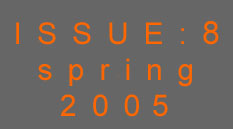

Tapping Unusual Quarters: a personal view by Andrew
Teller, ENS society manager
Making progress on the communication front
Attending PIME1 (the last issue took
place last February in Paris) is always a thought- provoking experience.
One cannot say that there is a palpable build-up of knowledge
from one year to the next: communication is not a hard science,
but is surely is a skill that can be improved. And one definitely
came away with the feeling that nuclear communicators are improving
theirs. The participants exchanged as usual their most noteworthy
experiences, leading to the emergence of best practices. Among
many valuable presentations, I would like to mention “Measuring
what cannot be seen: how to gauge your corporate reputation”
by Susan P. Brissette, from Bruce Power, Canada.
While everybody was focussing on positive results, she devised
a clever way of taking account of the negative ones that have
been avoided (for more information on this: link).
Not so long ago, the nuclear industry was still grappling with
the hard fact that facts and figures were not enough to sway public
opinion. These days are clearly gone. The industry has become
much more professional in the way it deals with public issues
and is putting in all the efforts necessary to understand the
psychological phenomena at play.
A noteworthy example of this trend towards professionalism
is an investigation launched by Philippe d’Iribarne,
a reputed French social scientist. He applied on a large scale
the techniques developed for consumer behaviour research to assess
how opinions on nuclear energy are formed in the general public.
The results of this investigation are due to be published in May
this year. One can expect that its results will enable nuclear
communicators to fine-tune their messages further. There will
be more on this in the autumn issue of this e-Bulletin.
The drive towards ensuring better public acceptance
is not confined to communicators. The task of the latter will
be made easier if those at the source of potential bones of contention,
i.e. the engineers, develop greater awareness of the consequences
of their activities. This concern is now taken care of in books
aimed at engineers. “Making Technology Work – Applications
in Energy and the Environment2” is to be commended
for filling a clear gap in the curriculum of engineering schools.
The authors, both professors at the Massachusetts Institute of
Technology, draw on their personal experience to put energy-related
projects into their proper context, which means that they go far
beyond the technical aspects. The book succeeds in happily merging
three lines of enquiry. It provides a wealth of technical information
on the various energy sources; it highlights the societal dimension
of their implementation and it provides the econometric tools
needed to assess their cost-effectiveness. I would warmly recommend
it to anybody interested in energy issues.
Still on the communication front, it is interesting
to note that experiencing difficulties is not specific to the
nuclear sector. Faithful to my habit of listening to unusual quarters,
I tried to find out from the Internet how the communicators in
the environmentalist circles were faring. In many instances, their
problems mirror those of the nuclear sector. For all the successes
they have scored, green communicators feel there is no room for
complacency. Pollution is not decreasing as much as intended;
energy is higher than they would like. Raising awareness relative
to environmental matters was relatively easy, but explaining more
complex concepts, such as sustainability, appears to be much more
challenging. They fret about the increasing energy needs of developing
countries. They also feel a need to make their messages clearer
and to listen more to their partners, such as educators, broadcasters
and journalists. Their pragmatic, result-oriented approach is
to be noted, even if it cannot be copied. Their main goal is avowedly
to change people's behaviour. Having observed that imparting the
relevant information is not enough to change attitudes and that
a change in attitude does not necessarily result in a change of
behaviour, many green movements have opted for legislative action
in order to have their goals enforced. If you ever wondered why
the Green parties were so active in the European Parliament, now
you know.
1
Should you need a reminder, PIME stands for Public Information
Material Exchange.
2 by John M.
Deutch and Richard K. Lester, Cambridge University Press, Cambridge
2004, 272 p.
|







